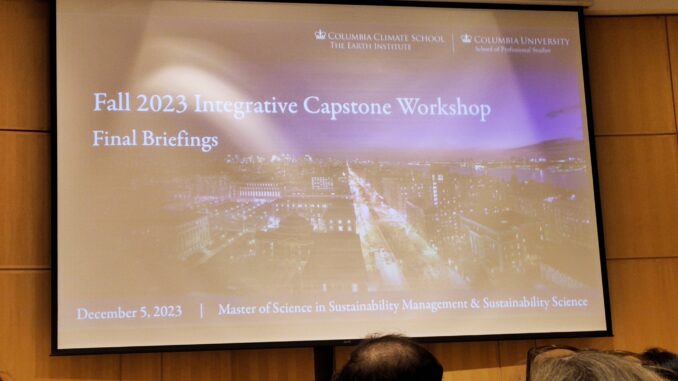
BY JOSH NARISMA
Delivery trucks are spewing increasing levels of pollution across New York State, prompting the State Senate to adopt legislation intended to curb such emission levels. Hundreds of thousands of packages enter Manhattan alone on a yearly basis, and this number is only going up. The environmental impact of e-commerce was one of the major topics of discussion at the Columbia University capstone briefings on December 5.
Environmental professionals and climate academics gathered at the Kraft Center for Jewish Student Life to watch Masters students present their projects for the Sustainability Management and Sustainability Science Programs. The students were divided into groups that spent the fall semester working closely with different clients to collect data on pertinent topics such as commercial pollution and urban sustainability.
The client for one capstone group, advised by Gerry Paul from the Columbia Climate School, was Open Plans, a nonprofit organization describing themselves as using “grassroots advocacy and policy change to inspire structural reforms and cultural shifts.” Tactical urbanism is a core tenet of Open Plans, which seeks to make NYC streets more livable by reducing roadside hazards and pollutants caused by “car culture.” Their legislative agenda for 2024 involves collaboration with the City Council, Borough Presidents, administrative agencies, and State authorities.
It is difficult to identify the environmental impacts of e-commerce. According to the presenter, “It’s a huge problem. First, we know […] there’s a lot of packages, those packages have to come in a lot of trucks, and those trucks are causing a lot of traffic due to the double parking, and thus [create] more emissions.”
Her research team sought to quantify these emissions by breaking down the issue of e-commerce into an equation. Their variables were 1) market distribution and Amazon’s Manhattan delivery data, 2) collected observations such as video accounts and interviews with truck drivers, 3) traffic data and greenhouse gas emissions factors, and 4) traffic volume data from the New York State Department of Transportation plus sensor data from the company Numina.
The presenter said, “We’ve learned that over 500,000 packages are being delivered to Manhattan alone, and that this number is increasing 14 percent annually. All of those packages are coming in [on] about 850 trucks per day.” This equals roughly 36 trucks per square mile in Manhattan.
Although each case study yields different results, this research team found an average of 0.06 grams of particulate matter per truck. “This may seem like a small number,” the presenter said, “however, this scaled up – if we were to use these exact conditions – would be 65,000 grams.”
One law seeking to limit pollutants caused by delivery trucks is Senate Bill S5895, which aims to curb emissions by creating an additional 25 cent surcharge on online delivery sales. This surcharge will appear as a separate line item on customers’ receipts. The bill was proposed by Senator Andrew Gounardes, who represents western Brooklyn. The revenue from this surcharge would be used to fund the infrastructure needed to shift freight from roadways to alternative modes of transportation such as water and rail. Additionally, Bill S5895 seeks to repair the Brooklyn Queens Expressway, “which is in need of $1.5 billion to rehabilitate sections of the expressway literally crumbling under the weight of illegally overweight trucks.”
A major culprit in e-commerce emissions are ‘last-mile warehouses’, or facilities where packages are stored before embarking on the last mile of their journey to the customer’s doorstep. According to Bill S5895, these mass distribution centers are much larger than traditional warehouses and “attract a significantly higher volume of trucks, which are bigger in size and thus more polluting.”
A pilot program launched by the DOT last summer tested the effectiveness of local delivery hubs, or microhubs, which “provide designated curbside or off-street locations for delivery trucks to unload items onto smaller, low-emissions vehicles or human-powered modes of transportation like cargo bikes and hand carts for the final leg of deliveries.” This was accompanied by the rapid installation of additional loading zones across the five boroughs. A later press release stated that microhubs have been shown to decrease emissions and reduce failed deliveries, street congestion, and vehicle travel distances.
The capstone group at Columbia University supported the incorporation of microhubs, stating that emissions can be offset by having deliveries made via “e-bikes or walking for that last mile or last bit of delivery — essentially getting rid of those double-parked trucks.”
Based on their research with OpenPlans, they also suggested street-curb reservation systems which have been implemented in cities such as DC, Philadelphia, and London. These provide predetermined parking so that trucks don’t all show up at the same time, and can be readily added to existing NYC pilot programs.
